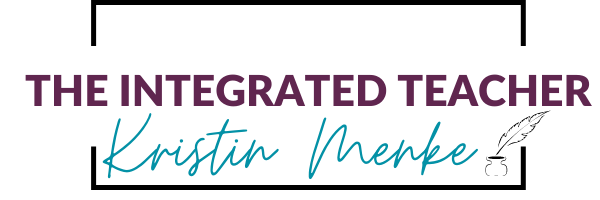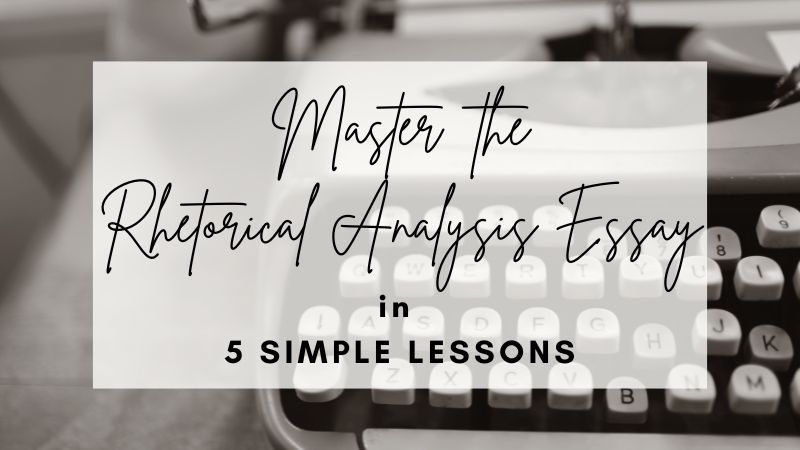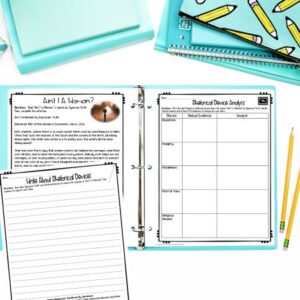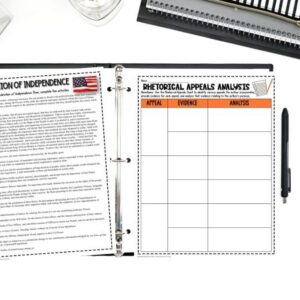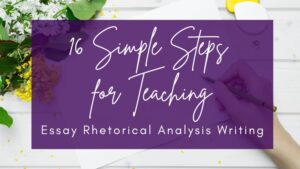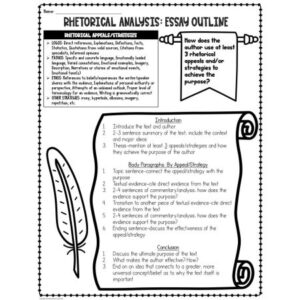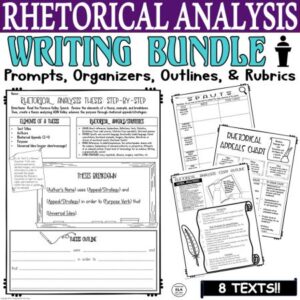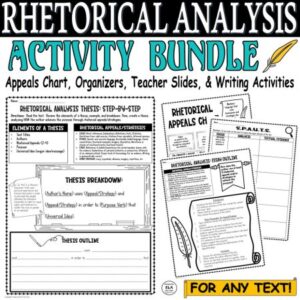One of my absolute favorite types of essays to teach is the Rhetorical Analysis Essay. I know I may not have many kindred spirits with this mindset, and that’s understandable. It has taken me many years and hundreds of hours reading rhetorical analyses to think this way.
Can you imagine then what our students think about writing a rhetorical analysis essay?
Writing, let alone teaching, a rhetorical analysis essay can be quite a feat for the average person, let alone the average teenager.
But, the skill of analyzing rhetoric is vital in today’s world. Students need to enter the adult world with the ability to discern what people say, what they actually mean, and the strategies they use to create and bolster their arguments.
Because of the onslaught of the written word and platforms for oral rhetoric, we MUST teach students how to dissect what they read and hear on a daily basis.
Keep reading to Master the Rhetorical Analysis Essay in 5 Simple Lessons!
Need help with Test Prep? Check out this FREE Pack of 3 Test Prep Activities to help students achieve success on standardized tests!
Master Rhetorical Analysis Essay Writing in 5 Simple Lessons
We as teachers must review certain elements of rhetoric before, during, and after reading. While writing a rhetorical analysis essay is simple, it is NOT easy. Feel free to read the lesson topics and ideas below several times throughout the writing process.

1. The Rhetorical Situation
First and foremost, teach students about the Rhetorical Situation before even mentioning they will write a rhetorical analysis essay. In fact, you may want to focus on just this concept for two or three days before moving on.
The RHETORICAL SITUATION sets up the piece of rhetoric by considering the following:
- Topic-the rhetoric’s subject matter
- Exigence-the circumstances that provoke the rhetoric into being
- Context-the time and place surrounding the rhetoric
- Audience-the person or group of people the rhetoric is intended for
- Purpose-what the rhetoric hopes to accomplish
- Rhetor-the creator/writer of the rhetoric
Let’s consider Sojourner Truth’s “Ain’t I a Woman?” speech from the mid-1800s.
- Topic-Women’s and African American rights
- Exigence-slavery in the South and her personal life experiences
- Context-1851, at the Women’s Convention, 10 years before the Civil War
- Audience-women and voting men
- Purpose-freedom and equal rights for all
- Rhetor-Sojourner Truth, woman, wife, mother, former slave, speaker
All of these rhetorical situation elements should be identified and thoroughly examined in order to fully understand a specific piece of rhetoric and write about it in a rhetorical analysis essay. There is no easy way around the process. It takes time and practice.
I would consider using the following texts and formats:
- “Ain’t I a Woman?”
- “A Modest Proposal”
- “Sinners in the Hands of an Angry God”
- “Give Me Liberty or Give Me Death”
- “Gettysburg Address”
- Declaration of Independence
- “Declaration of Sentiments”
- “Sending Grandma to the Ovens”
- FDR’s “Infamy” Speech
- Florence Kelley’s Child Labor Speech
- Famous pieces of art
- Advertisements
- Songs
- Poems
Most texts, even fictional ones, have a rhetorical situation. Certain elements might be a bit muddled, but it is fun to explore and check out what could be purposeful and impactful rhetoric!
2. The Rhetorical Appeals & Strategies
In order to fully grasp rhetorical analysis, students need to learn about the appeals and various techniques or strategies a rhetor might employ in crafting the rhetoric.
I once read that rhetorical strategies are like tools. We use different tools for various purposes, and people don’t always need to use the same tools to achieve a similar effect.
For example, a person may use a lot of PATHOS (emotionally driven language) in a political speech, especially if the argument to vote for the person is actually weak. Using LOGOS (primarily facts and statistics) may not work in this case.
Conversely, when talking to a customer of a fancy restaurant, a server may use more colorful or emotional language (PATHOS) to hype up the whole experience: the food, the ambiance, and the overall setting. Using statistics would hardly be helpful in this situation.
So, introducing various appeals and strategies is primary when we want students to be able to craft a rhetorical analysis essay. I like defining and modeling the following:
- Logos
- Pathos
- Ethos
- Allusion: religious, mythical, literary, Biblical, and historical
- Hyperbole
- Understatement
- Tone
- a Specific Diction (Style)
- Sentence Structure (Syntax)
- Figurative Language (Metaphor, Simile, Personification, Oxymoron)
- Imagery
- Repetition
- Fallacies
This list covers most of what students will need to achieve success! Below are examples of several of the devices and how to analyze the purpose of the devices/evidence.
Declaration of Independence
Emotional Imagery
Evidence: Ex. “He has plundered our seas, ravaged our Coasts, burnt our towns, and destroyed the lives of our people.”
“Sinners in the Hands of an Angry God”
Biblical Allusion
Evidence: Ex. “They don’t only justly deserve to be cast down thither, but the sentence of the law of God, that eternal and immutable rule of righteousness that God has fixed between him and mankind, is gone out against them, and stands against them; so that they are bound over already to hell: John iii. 18, ‘He that believeth not is condemned already.’”
I like using this Verbs List to guide my students in writing effective analysis/commentary during and after they read the rhetoric. It makes the planning and drafting process SO MUCH easier!
Need a rhetorical analysis essay outline to make writing easier? Click below!
3. Prewriting the Rhetorical Analysis Essay
I personally prefer using the SPAUTS method to help my students comprehend the rhetorical situation, locate various strategies used by the rhetor, and plan for their first essay.
S-Speaker: Who is the author or creator?
P-Purpose: What is the purpose of the text?
A-Audience: Who is the intended audience?
U-Universal Ideas: What are some major ideas/messages from the text?
T-Tone: What is the tone of the author/creator?
S-Strategies: What strategies (appeals, devices, elements) does the author/writer use to achieve the purpose?
Afterward, you will need to model how to find the best evidence and comment on it.
Here are examples from President Barak Obama’s Speech “The Audacity of Hope:”
I’m talking about something more substantial. It’s the hope of slaves sitting around a fire singing freedom songs; the hope of immigrants setting out for distant shores; the hope of a young naval lieutenant bravely patrolling the Mekong Delta; the hope of a millworker’s son who dares to defy the odds; the hope of a skinny kid with a funny name who believes that America has a place for him, too.
Hope — Hope in the face of difficulty. Hope in the face of uncertainty. The audacity of hope! In the end, that is God’s greatest gift to us, the bedrock of this nation. A belief in things not seen. A belief that there are better days ahead.”-from The Audacity of Hope by President Barak Obama
Historical Allusion- The reference to “slaves…singing freedom songs” provides an introduction to the past. It elicits hope in the midst of the horrors of a country previously mired in the evils of slavery. He references this group of people to encourage the audience to sing their own songs of freedom and liberty regarding the future.
Imagery- The description of “immigrants” evokes empathy for those hoping for a better life in America. The images of the length of time and distance convey a journey many have taken to reach America’s shores for a better life.
Alliteration- The phrase “dares to defy” helps to highlight the plight of everyday people who could challenge the system. He sets up the audience, gearing them up to take on this challenge and succeed.
If students take the time to write out commentary/analysis before drafting the essay, the actual writing process is simple and seamless!
4. Drafting the Essay
I use sentence-by-sentence outlines when writing a rhetorical analysis essay. I rarely stray from this specific writing style because it is super effective and necessary for most students beginning the journey.
Here are outlines for an Introduction and Body Paragraphs:
- Introduce the text, topic, and author
- 2-3 sentence summary of the text; include the context and major ideas
- Thesis-include the devices, purpose, audience, and author
Sample Body Paragraph based on the Declaration of Independence:
- Topic Sentence- Throughout this text, Jefferson uses factual information in order to validate the call to independence.
- Evidence-In the list of his reasons, he states that the king “has erected a multitude of New Offices, and sent hither swarms of Officers to harass our People, and eat out their substance.”
- Commentary/Analysis- This information highlights the simple fact that the king created jobs simply to “harass” the colonists and to take their resources. Through this language, Jefferson substantiates the argument that Americans have been treated unfairly.
- Evidence & Transition- Furthermore, he describes, “For quartering large bodies of armed troops among us…For protecting them, by a mock Trial, from Punishment for any Murders which they should commit on the Inhabitants of these States.”
- Commentary/Analysis- Through the reference to the Quartering Act, Jefferson reminds the king and the English government of the devastating effects of his troops. Unlike true English citizens, they are subjected to ill-treatment that transcends any sense of morality. He clarifies that the troops are protected from prosecution, even when they commit “Murders,” an obviously unjustifiable situation.
- Ending Sentence- Using logic, Jefferson supports his belief that the Americans are justified in their desire to separate from England.
When creating a conclusion, I would simply reiterate the devices and purpose as well as the overall effectiveness of the strategies. Connecting the rhetoric to other texts, moments in time, or themes/universal ideas is also helpful!
5. Self or Peer Editing the Rhetorical Analysis Essay Draft
The editing/revision process for the rhetorical analysis essay does not have to be boring and long. In fact, I like to jazz it up in various ways.
- If this is the first essay, take students sentence by sentence through their essays. Do they have 3-4 sentences in their introductions? Do they have a thesis? Do they have 2-3 body paragraphs? A quick skim is all that is needed for students to see what they wrote and what they should or shouldn’t have.
- Highlight important elements of the rhetorical analysis essay: Thesis and Topic/Ending Sentences in one color to see how they connect with each other. Evidence in another color. Commentary/Analysis in yet a different color.
- Encourage students to pair up and trade their essays. Have students read the introductions and/or body paragraphs aloud. Hearing their own writing is so helpful in the revision/editing process.
- Share good examples for each paragraph of the rhetorical analysis essay based on different students in the class.
- Use rubrics and exemplars to score, especially for students in advanced classes. They need to see examples of below-level, on-level, and high-level writing.
- Incorporate Shout-Outs. Students can write down 1 thing another student did well in his/her essay and post or tell the class about it.
After going through this 30-40 minute self or peer editing time, allow students to revise if you have time. Perhaps just focus on revising one or two paragraphs instead of the whole essay. Remember that the goal is to set students up for further success on future essays, NOT simply give a grade IF a student actually tried.
There are so many rhetorical analysis essay lessons out there, but I like this one with a teacher presentation and step-by-step guides!
Rhetorical Analysis Essay Resources
This Rhetorical Analysis Essay Writing BUNDLE includes a rhetorical analysis example in every lesson and helps students create thesis statements, outline essays, examine nonfiction / informational texts, write short responses, and analyze rhetorical appeals (logos, pathos, and ethos).
Teach rhetorical analysis EASILY with a step-by-step process!
Make teaching Rhetorical Analysis & the Rhetorical Situation EASY with this Rhetorical Analysis Essay Writing Bundle, which helps students create thesis statements, outline essays, examine nonfiction texts, write short responses, and analyze rhetorical appeals.
***Plus, these activities can be used with ANY text!***
Need more Rhetorical Analysis Essay activities? Check out my store, Kristin Menke-Integrated ELA Test Prep!
